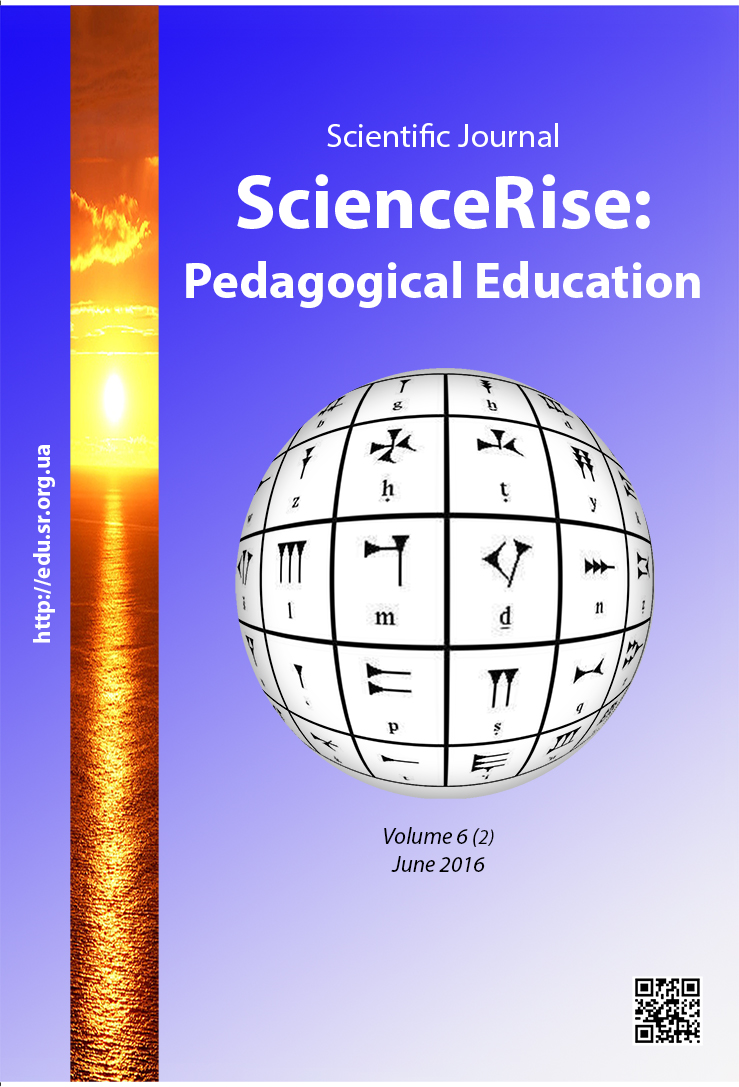Methodology of teaching of the discipline "Endocrinology" with the use of case-technologies
DOI:
https://doi.org/10.15587/2519-4984.2016.72715Keywords:
case, technology, method, methodology, discipline, internal medicineAbstract
Aim of research – to theoretically ground, elaborate and partially verify the methodology of teaching of the discipline “Internal medicine” using case-technologies in KNMU.
Object of research – the process of teaching students of the higher educational institutions.
Subject of research – the methodology of teaching of the discipline “Internal medicine” in KNMU using case-technologies.
In the work were analyzed the possibilities of use of case-technologies of learning in the process of teaching of the discipline “internal medicine” and determined the pedagogical aims, main directions, principles and forms of their use, methods of teaching.
There was elaborated the methodology of teaching of the discipline “Internal medicine” using case-technologies”.
There were experimentally grounded the rise of indices of effectiveness of learning process and in such a way grounded an expediency of the use of elaborated methodology at teaching of the discipline “Internal medicine”.
Scientific novelty is concluded in elaborated and experimentally verified methodology of teaching of the discipline “Internal medicine” with the help of case-technologies.
The materials of research namely the elaborated methodology of of teaching of the discipline “Internal medicine” with the help of case-technologies can be used by the teachers of the higher educational institutions at the professional preparation of future doctors
References
- Barahsanova, E. F., Mordovskaja, A. V., Panina, S. V. (2012). Scientific and methodological support of basic educational program for graduate students through case-technology. Philosophy of Education, 1, 187–192.
- Sokol, O. M. (2015). Zastosuvannja aktyvnyh metodiv navchannja jak sposib pidvyshhennja navchal'no-piznaval'noi' dijal'nosti studentiv-medykiv. Urgent Problems of Science and Practice in the XXI Century. United Kingdom, London, 55–59.
- Eremin, A. S. (2010). Development and testing of cases: especially the development of case studies, the choice of the main features of the case, the plan and the text of the case. Innovations in Education, 3, 15–36.
- Zhigiley, I. M. (2012). Formation of professional competence by means of case-method in Higher Education. Teacher of XXI century, 1, 29–36.
- Nelovkіna-Bernal, O. A. (2010). Pedagogіchnі minds formuvannya profesіynoї spryamovanostі studentіv medichnih spetsіalnostey. News іmenі Luhansk Taras Shevchenko, 10 (197), 12–21.
- Psihologіya i pedagogy. Carrying іndivіdualnogo zanyattya method for specific analіzu The Teaching situatsіy (case study) (2012). Lviv: LІBS UBS NBU, 145.
- Amaratunga, D., Baldry, D. (2001). Case study methodology as a means of theory building: performance measurement in facilities management organisations. Work Study, 50 (3), 95–105. doi: 10.1108/00438020110389227
- Cameron, A., Trudel, M., Titah, R., Leger, P., Blakey, P. (2012). The live teaching case: a new IS method and its application. Journal of Information Technology Education, 11, 27–42.
- Kelly, G. A. (1955). The psychology of personal constructs. Vol. 1. A theory of personality. N.Y.: Norton, 556.
- Feagin, J., Orum, A., Sjoberg, G. (1991). A case for case study. NC: University of North Carolina Press, 98.
Downloads
Published
How to Cite
Issue
Section
License
Copyright (c) 2016 Ольга Вікторівна Лахно

This work is licensed under a Creative Commons Attribution 4.0 International License.
Our journal abides by the Creative Commons CC BY copyright rights and permissions for open access journals.
Authors, who are published in this journal, agree to the following conditions:
1. The authors reserve the right to authorship of the work and pass the first publication right of this work to the journal under the terms of a Creative Commons CC BY, which allows others to freely distribute the published research with the obligatory reference to the authors of the original work and the first publication of the work in this journal.
2. The authors have the right to conclude separate supplement agreements that relate to non-exclusive work distribution in the form in which it has been published by the journal (for example, to upload the work to the online storage of the journal or publish it as part of a monograph), provided that the reference to the first publication of the work in this journal is included.








